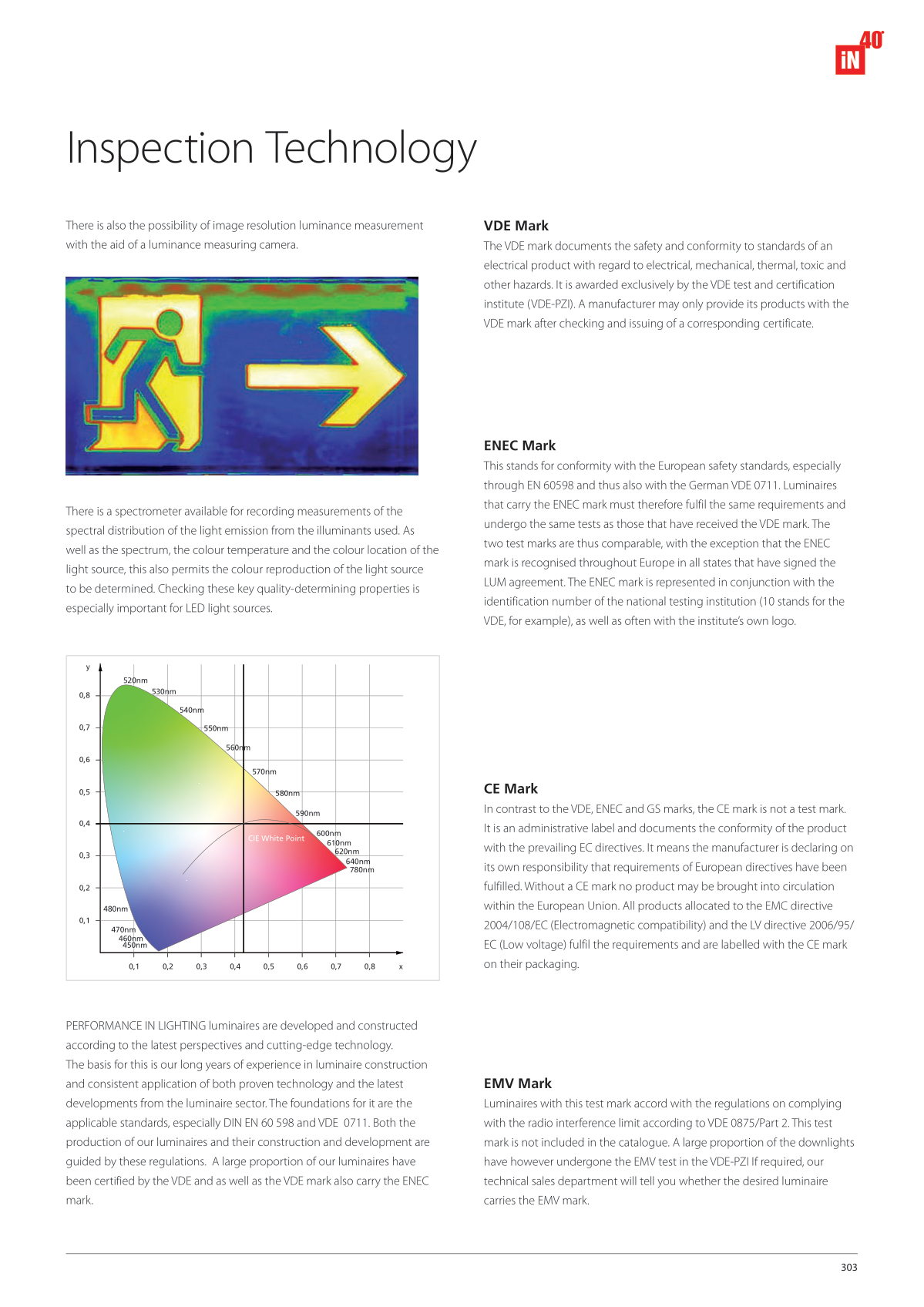303
0,1
0,2
0,3
0,4
0,5
0,6
0,7
0,8
y
0,1
0,2
0,3
0,4
0,5
0,6
0,7
0,8
x
CIE White Point
520nm
530nm
540nm
560nm
570nm
580nm
550nm
590nm
600nm
610nm
620nm
780nm
640nm
480nm
470nm
460nm
450nm
Inspection Technology
There is also the possibility of image resolution luminance measurement
with the aid of a luminance measuring camera.
VDE Mark
The VDE mark documents the safety and conformity to standards of an
electrical product with regard to electrical, mechanical, thermal, toxic and
other hazards. It is awarded exclusively by the VDE test and certification
institute (VDE-PZI). A manufacturer may only provide its products with the
VDE mark after checking and issuing of a corresponding certificate.
There is a spectrometer available for recording measurements of the
spectral distribution of the light emission from the illuminants used. As
well as the spectrum, the colour temperature and the colour location of the
light source, this also permits the colour reproduction of the light source
to be determined. Checking these key quality-determining properties is
especially important for LED light sources.
PERFORMANCE IN LIGHTING luminaires are developed and constructed
according to the latest perspectives and cutting-edge technology.
The basis for this is our long years of experience in luminaire construction
and consistent application of both proven technology and the latest
developments from the luminaire sector. The foundations for it are the
applicable standards, especially DIN EN 60 598 and VDE 0711. Both the
production of our luminaires and their construction and development are
guided by these regulations. A large proportion of our luminaires have
been certified by the VDE and as well as the VDE mark also carry the ENEC
mark.
ENEC Mark
This stands for conformity with the European safety standards, especially
through EN 60598 and thus also with the German VDE 0711. Luminaires
that carry the ENEC mark must therefore fulfil the same requirements and
undergo the same tests as those that have received the VDE mark. The
two test marks are thus comparable, with the exception that the ENEC
mark is recognised throughout Europe in all states that have signed the
LUM agreement. The ENEC mark is represented in conjunction with the
identification number of the national testing institution (10 stands for the
VDE, for example), as well as often with the institute’s own logo.
EMV Mark
Luminaires with this test mark accord with the regulations on complying
with the radio interference limit according to VDE 0875/Part 2. This test
mark is not included in the catalogue. A large proportion of the downlights
have however undergone the EMV test in the VDE-PZI If required, our
technical sales department will tell you whether the desired luminaire
carries the EMV mark.
CE Mark
In contrast to the VDE, ENEC and GS marks, the CE mark is not a test mark.
It is an administrative label and documents the conformity of the product
with the prevailing EC directives. It means the manufacturer is declaring on
its own responsibility that requirements of European directives have been
fulfilled. Without a CE mark no product may be brought into circulation
within the European Union. All products allocated to the EMC directive
2004/108/EC (Electromagnetic compatibility) and the LV directive 2006/95/
EC (Low voltage) fulfil the requirements and are labelled with the CE mark
on their packaging.


